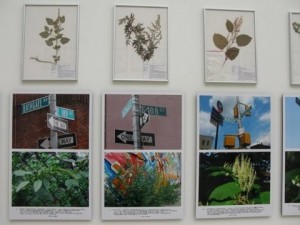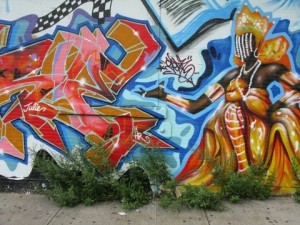The Art in Ethnobotany
Posted in People, Science on June 23 2009, by Plant Talk
Garden Scientist Participates in the Venice Biennale
 |
Ina Vandebroek, Ph.D., is a Research Associate and Project Director of Dominican Traditional Medicine for Urban Community Health with the Botanical Garden’s Institute of Economic Botany. Photo of Ina by Bert de Leenheer |
 Every two years, Venice turns into the Cannes of the art world for La Biennale di Venezia: an international festival of art—with a capital “A.” From June to November, this city that always counts more visitors than residents becomes the scene for everything and everyone involved in the arts: curators, art critics, collectors, art aficionados, and, of course, the artists themselves. This year I participated as an ethnobotanist who collaborated with the Belgian contemporary artist Jef Geys for the 53rd Biennale, called Fare Mundi (Making Worlds).
Every two years, Venice turns into the Cannes of the art world for La Biennale di Venezia: an international festival of art—with a capital “A.” From June to November, this city that always counts more visitors than residents becomes the scene for everything and everyone involved in the arts: curators, art critics, collectors, art aficionados, and, of course, the artists themselves. This year I participated as an ethnobotanist who collaborated with the Belgian contemporary artist Jef Geys for the 53rd Biennale, called Fare Mundi (Making Worlds).
You might wonder what an ethnobotanist has to do with art? I usually spend most of my days in the field with my nose stuck in plants, collecting them to make botanical specimens and identify their Latin names. Or, I conduct interviews with people to find out how these plants are used by local cultures, such as in traditional medicines. But now I found myself flying to the city of gondolas and vaporettos (water taxis) to assist in the inauguration of the Belgian pavilion where the installation from Jef Geys is on display.
When I was 13 years old and still living in Belgium, Jef was my art teacher. I remember making conventional drawings in art class, but Jef was by no means a conventional art teacher. He likes to challenge his surroundings and the people in it, and by doing so subtly makes them change their perceptions about art and life. He offers no lessons; instead, the experience itself is the lesson. Now, so many years later, I relived that experience when Jef asked me to apply the methods I had acquired during my training as an ethnobotanist at The New York Botanical Garden to “go out in the urban fields of New York City and collect 12 plants growing in the streets of my home in the Bronx that could be used as medicines by homeless people.” Jef asked other acquaintances from the art world who live in Moscow, Brussels, and Villeurbanne (France) to do the same thing and guided them with the methodology.
 Almost all the plants I collected in New York City are considered weeds because they grow in places where no one wants them, such as sidewalks or abandoned lots. Weeds take care of themselves and are pioneers in man-made settings around the globe, including cities. They are often inconspicuous or not paid attention to. But they are fierce, surviving in harsh environments, and they use their chemical defense systems to do so. The chemical molecules these plants produce make them valuable as medicine, too, research has shown. These properties are what led me to collect the following species: 1) American linden (Tilia americana L.); 2) Mexican tea (Chenopodium ambrosioides L.); 3) American pokeweed (Phytolacca americana L.); 4) Bittersweet nightshade (Solanum dulcamara L.); 5) Black nightshade (Solanum nigrum L.); 6) Common plantain (Plantago major L.); 7) Oriental lady’s-thumb (Polygonum cespitosum Blume var. longisetum); 8) Poor man’s pepper (Lepidium virginicum L.); 9) Green amaranth (Amaranthus hybridus L.); 10) Mugwort (Artemisia vulgaris L.); 11) Japanese knotweed (Fallopia japonica (Houtt.) Ronse Decr.); and 12) White snakeroot (Ageratina altissima (L.) R.M. King & H. Rob.).
Almost all the plants I collected in New York City are considered weeds because they grow in places where no one wants them, such as sidewalks or abandoned lots. Weeds take care of themselves and are pioneers in man-made settings around the globe, including cities. They are often inconspicuous or not paid attention to. But they are fierce, surviving in harsh environments, and they use their chemical defense systems to do so. The chemical molecules these plants produce make them valuable as medicine, too, research has shown. These properties are what led me to collect the following species: 1) American linden (Tilia americana L.); 2) Mexican tea (Chenopodium ambrosioides L.); 3) American pokeweed (Phytolacca americana L.); 4) Bittersweet nightshade (Solanum dulcamara L.); 5) Black nightshade (Solanum nigrum L.); 6) Common plantain (Plantago major L.); 7) Oriental lady’s-thumb (Polygonum cespitosum Blume var. longisetum); 8) Poor man’s pepper (Lepidium virginicum L.); 9) Green amaranth (Amaranthus hybridus L.); 10) Mugwort (Artemisia vulgaris L.); 11) Japanese knotweed (Fallopia japonica (Houtt.) Ronse Decr.); and 12) White snakeroot (Ageratina altissima (L.) R.M. King & H. Rob.).
It was a fantastic experience to go out on weekend mornings to hunt for plants, armed with a portable plant press, newspapers, corrugated cardboards, and my camera. I also noticed that my walk from work to my home in “Little Italy of the Bronx” acquired a new dimension. Instead of walking deep in thoughts without noticing too much of my surroundings, I became obsessed with finding interesting plants that would make nice collections and photographs. I was amazed at how many different plants were growing in an area of 100 hectares (about 250 acres). It was not hard to find the 12 plants; to be honest, I found it hard to stop at 12. People from the neighborhood often came by to ask questions when they saw me digging out a weed or photographing a plant or its “home address,” the street sign of the place where it was growing, and cheered when I told I was a researcher who investigates plants and was working on an art project.
Jef named the final installation Quadra Medicinale (Medicinal Quadrant). The work also includes line drawings, maps, descriptions, and inventories made by Jef as well as a special edition of a house-to-house journal that he has published independently over the past 38 years. It was Jef’s intention to make this journal 100 percent “edible” for the Biennale, but technology has not yet evolved enough to achieve this.
I had not seen the completed display until I walked into the Belgian pavilion on the first preview day of the Biennale, and it literally took my breath away. The plants and pictures were arranged in a three-dimensional quadrant and emanated scientific rigor as well as simplicity and refreshing orderly stillness. Through this work of art I also saw a man’s ode to science. Jef’s installation is a vivid example of how art and science can come together to create something that adds new meaning to how we view and interact with the world around us. It is also a work that will keep acquiring new meanings. In one of the line drawings that accompanies the installation, Jef already reveals some of the names of new cities in which this initiative may be replicated. The future will tell how this urban ethnobotany art collection will grow over time.
I am indebted to Jef and the people from Wiels, Contemporary Art Centre Brussels, for the experience of participating in this project.

